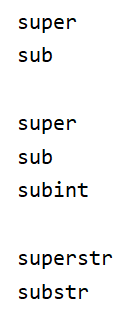继承,super关键字
public class TestSuperSub {
public static void main(String[] args) {
Sub s1 = new Sub();
System.out.println();
Sub s2 = new Sub(1);
System.out.println();
Sub s3 = new Sub("a");
}
}
class Super {
public Super() {
System.out.println("super");
}
public Super(String string) {
System.out.println("superstr");
}
}
class Sub extends Super{
public Sub(){
System.out.println("sub");
}
public Sub(int i) {
this();
System.out.println("subint");
}
public Sub(String string) {
super(string);
System.out.println("substr");
}
}
结果:

在实例化子类对象时,会优先实例化父类。如果子类的构造函数中有通过super关键字调用父类的构造方法,在实例化父类时会使用这个指定的构造方法,如果没有指定,就会默认使用空参的构造方法。

若一个父类中只有一个或多个带参数的构造方法,那么在写其子类的构造方法时必须先通过super调用父类的构造方法才能完成子类的构造方法而且super只能写在子类构造方法体内的第一行。
父类的引用可以调用子类中重写的父类的方法,但不能调用子类中独有的方法,即不能调用父类中不存在,子类中存在的方法。
class Father{
public void eat(){
System.out.println("father eat");
}
}
class Son extends Father{
@Override
public void eat() {
System.out.println("son eat");
}
public void work(){
System.out.println("son work");
}
}
public class FatherSon {
public static void main(String[] args) {
Father f1 = new Son();
f1.eat();
// f1.work();
}
}

当父类引用调用eat()时,实际上运行的是子类重写的eat()函数。

父类不能调用子类独有的方法。
